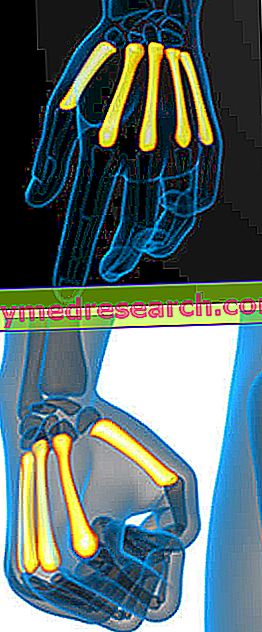Doxycycline is an antibiotic belonging to the tetracycline class. It has a broad spectrum of action and is available as tablets, capsules and periodontal gels.

Doxycycline - Chemical Structure
Indications
For what it uses
Doxycycline is used to treat infections caused by bacteria that are sensitive to it, both Gram-positive and Gram-negative.
More specifically, the use of doxycycline is indicated for the treatment of:
- Respiratory tract infections;
- Otorhinolaryngological infections;
- Skin and soft tissue infections;
- Gastrointestinal infections;
- Infections of the genitourinary system;
- Gynecological infections;
- Boils or red pimples caused by rosacea;
- Chronic and aggressive periodontitis (doxycycline is used as a periodontal gel).
Warnings
Doxycycline can cause photosensitivity reactions, therefore, exposure to sunlight and UV rays should be avoided during antibiotic therapy.
Treatment with doxycycline can promote the development of superinfections with bacteria resistant to doxycycline itself or from fungi, such as, for example, vaginal candidiasis or Clostridium difficile infection that can lead to the onset of pseudomembranous colitis.
Doxycycline therapy - especially if done at high doses and for long periods - can cause changes in liver function, therefore, regular checks must be performed.
Caution should be exercised when administering doxycycline in patients with renal insufficiency. In fact, in these patients, the renal excretion of doxycycline may decrease, with a consequent increase in the plasma concentration of the same. Increased plasma antibiotic concentration, in turn, can lead to the onset of liver damage.
Doxycycline can cause esophagitis and even severe esophageal ulcers. Therefore, it is recommended to take doxycycline with the help of a lot of water and to remain upright for at least an hour after the antibiotic is administered.
When doxycycline is administered for long periods, it is necessary to carry out regular checks of blood counts and liver and kidney function.
Like all tetracyclines, doxycycline can also be deposited in the teeth and bones during the period of formation and growth, can cause hypoplasia and can alter tooth coloring (the teeth may take on a yellow-brown color). Therefore, the antibiotic should not be administered during pregnancy, lactation and in children under 12 years of age.
Great caution should be used when administering doxycycline in patients with preexisting myasthenia gravis (a neuromuscular disease).
In patients already on oral anticoagulants who need to start treatment with doxycycline, adjustment of the doses of anticoagulants administered may be necessary.
Interactions
Simultaneous intake of doxycycline and the following drugs or foods may cause a decrease in doxycycline absorption:
- Antacid drugs containing aluminum, calcium and magnesium;
- Milk and dairy products ;
- Products containing iron salts ;
- Preparations containing zinc and bismuth .
Doxycycline may increase prothrombin time in patients receiving warfarin or other oral anticoagulants, therefore, during treatment with the antibiotic it may be necessary to reduce the dose of oral anticoagulant administered.
Doxycycline and penicillins can mutually interfere with their antibacterial activity, therefore, the combination of these two types of antibiotics should be avoided.
Phenobarbital, carbamazepine and phenytoin (drugs used in the treatment of epilepsy) can reduce the plasma half-life of doxycycline.
The half-life of doxycycline can also be decreased by the simultaneous intake of alcoholic beverages .
Doxycycline may decrease the effectiveness of oral contraceptives .
Doxycycline can increase the plasma concentration of ciclosporin (an immunosuppressive drug used in the prevention of transplant rejections).
The concomitant use of doxycycline and systemic retinoids should be avoided, as there is an increased risk of occurrence of benign intracranial hypertension.
Doxycycline may interfere with laboratory tests used to determine urinary catecholamines.
In any case, you need to inform your doctor if you are taking - or if you have recently been - drugs of any kind, including over-the-counter drugs and herbal and / or homeopathic products.
Side effects
Doxycycline can cause various types of side effects, although not all people experience them. This depends on the different sensitivity that each individual has towards the drug. Therefore, it is said that the undesirable effects do not all occur with the same intensity in each patient.
The main side effects that can occur during doxycycline treatment are listed below.
Allergic reactions
Doxycycline can trigger allergic reactions in sensitive patients. These reactions can occur in the form of:
- Schönlein-Henoch purpura;
- Hypotension;
- Angioedema;
- Peripheral edema;
- Tachycardia;
- pericarditis;
- Dyspnoea;
- Serum reaction;
- Drug rash with eosinophilia and systemic symptoms (also known as DRESS syndrome);
- Anaphylaxis.
Blood and lymphatic system disorders
Doxycycline therapy may promote the onset of:
- Neutropenia, ie decrease in the number of neutrophils in the bloodstream;
- Eosinophilia, that is the increase in the number of eosinophils in the bloodstream;
- Plateletopenia, ie decrease in the number of platelets in the blood;
- Hemolytic anemia.
Gastrointestinal disorders
Treatment with doxycycline may cause:
- Nausea or vomiting;
- Dyspepsia;
- Pseudomembranous colitis caused by superinfections with Clostridium difficile ;
- Esophagitis;
- Esophageal ulcers;
- Inflammation of the intestine;
- Abdominal pain;
- Diarrhea;
- Dysphagia;
- pancreatitis;
- Glossitis.
Hepatobiliary disorders
Doxycycline can cause changes in liver function, jaundice and hepatitis.
Endocrine disorders
Treatment with doxycycline can cause microscopic brown pigmentations on the thyroid.
Metabolism and nutrition disorders
Doxycycline therapy can promote the onset of anorexia and porphyria.
Skin and subcutaneous tissue disorders
Treatment with doxycycline may cause:
- Photosensitization reactions;
- Erythematous or maculopapular skin eruptions;
- Erythema multiforme;
- Stevens-Johnson syndrome;
- Exfoliative dermatitis;
- Toxic epidermal necrolysis;
- Photo-onycholysis.
Musculoskeletal and connective tissue disorders
Doxycycline therapy can cause:
- Myalgia;
- arthralgia;
- Worsening of the symptoms of myasthenia gravis in patients suffering from it.
Other side effects
Other side effects that may occur during treatment with doxycycline are:
- Headache;
- Inflammation of nose and throat;
- Sinusitis;
- Difficulty swallowing;
- Benign intracranial hypertension;
- Redness;
- Hypertension or hypotension;
- Anogenital candidiasis;
- Dry mouth;
- Tinnitus, that is an auditory disorder characterized by the perception of whistling, hissing, buzzing, tinkling, etc .;
- Increased azotemia and urea in the bloodstream;
- Worsening of the symptoms of systemic lupus erythematosus in patients who are affected.
Side effects associated with the application of periodontal gel
Following the application of the doxycycline-based periodontal gel, gum swelling may occur and a taste similar to chewing gum may be perceived.
Overdose
If you suspect you have taken an overdose of doxycycline, you must inform your doctor immediately and contact your nearest hospital.
In the event of an overdose, gastric lavage can be useful to eliminate excess antibiotic from the body.
Action mechanism
Doxycycline performs its bacteriostatic-type antibacterial action (ie it is able to inhibit the growth of bacterial cells, but not to kill them) by interfering with the protein synthesis of bacteria.
Protein synthesis in bacterial cells takes place thanks to organelles called ribosomes. These organelles consist of ribosomal RNA and proteins associated with each other to form two subunits: the 30S subunit and the 50S subunit.
The task of the ribosome is to bind and translate the messenger RNA coming from the cell nucleus and to synthesize the proteins for which it encodes.
Doxycycline is able to bind to the 30S ribosomal subunit, thus preventing the binding of messenger RNA to the same ribosome. In this way, protein synthesis is blocked.
Mode of Use - Posology
Doxycycline is available for oral administration in the form of tablets or hard capsules. Furthermore, it is also available as a periodontal gel.
The dosage and duration of treatment must be established by the doctor, depending on the type and severity of the infection to be treated.
Following are some indications on the doses of drug that are usually used in therapy.
Oral administration (tablets or capsules)
To treat infections of various kinds, usually tablets containing 100 mg doxycycline are used.
The usual doxycycline dose is 200 mg on the first day of treatment. From the second day on, however, the usual dose is 100-200 mg of the drug according to the opinion of the doctor.
The tablets should be taken whole, with plenty of water and at least an hour before bedtime, in order to avoid possible esophageal irritation.
Instead, for the treatment of boils and red pimples caused by rosacea, capsules are usually used which contain less doxycycline than that contained in the tablets described above.
In this case, the dose of doxycycline usually given is 40 mg, to be taken once a day, generally in the morning.
The capsules must be taken whole and with plenty of water in order to avoid possible esophageal irritation.
Regardless of the administration of the tablets or capsules, doxycycline should not be taken at the same time as milk or dairy products.
Periodontal gel
The doxycycline-based periodontal gel should only be administered by dentists, inside the periodontal pockets and using a special device.
After the application of the gel, for a period of at least seven days, brushing of the teeth in the treated area should be avoided.
Pregnancy and breastfeeding
Doxycycline can be deposited in the teeth and bones that are forming in the fetus and can cause problems for its growth. Therefore, the use of the drug by pregnant women should be avoided.
Doxycycline is excreted in breast milk and can cause harm to the infant. Therefore, breastfeeding mothers should not take the antibiotic.
Contraindications
The use of doxycycline is contraindicated in the following cases:
- In patients with known hypersensitivity to doxycycline itself;
- In patients with known hypersensitivity to other tetracyclines;
- In patients suffering from obstructive esophageal disorders, such as narrowing or esophageal achalasia;
- In children under 12 years of age;
- Pregnant;
- During breastfeeding.



